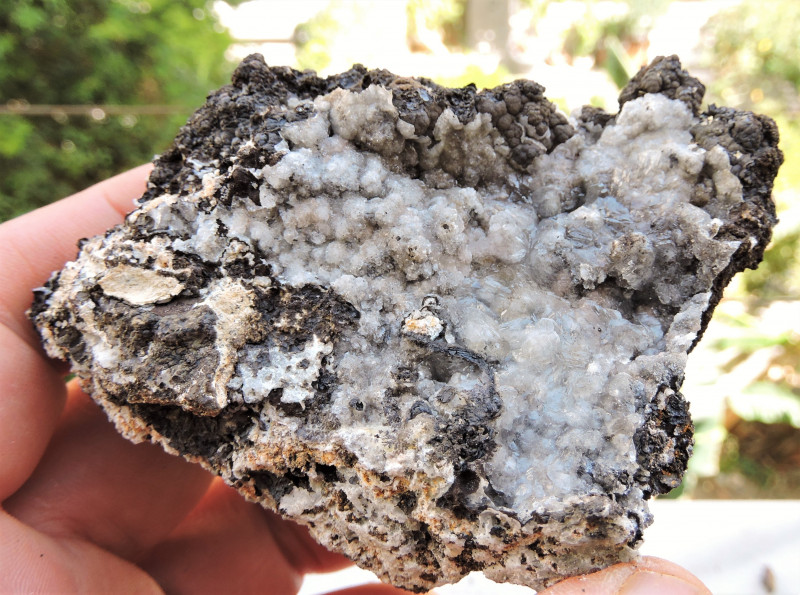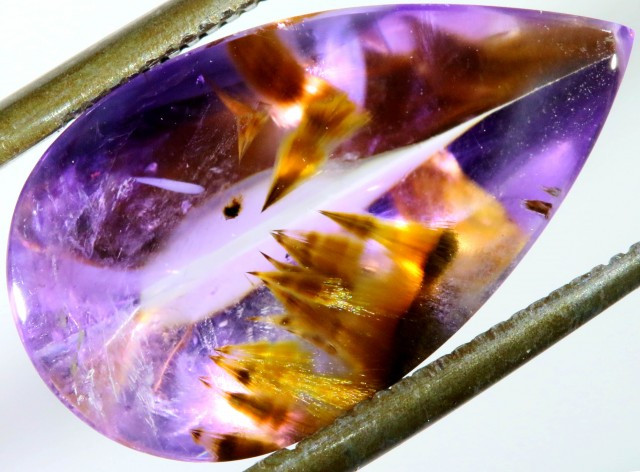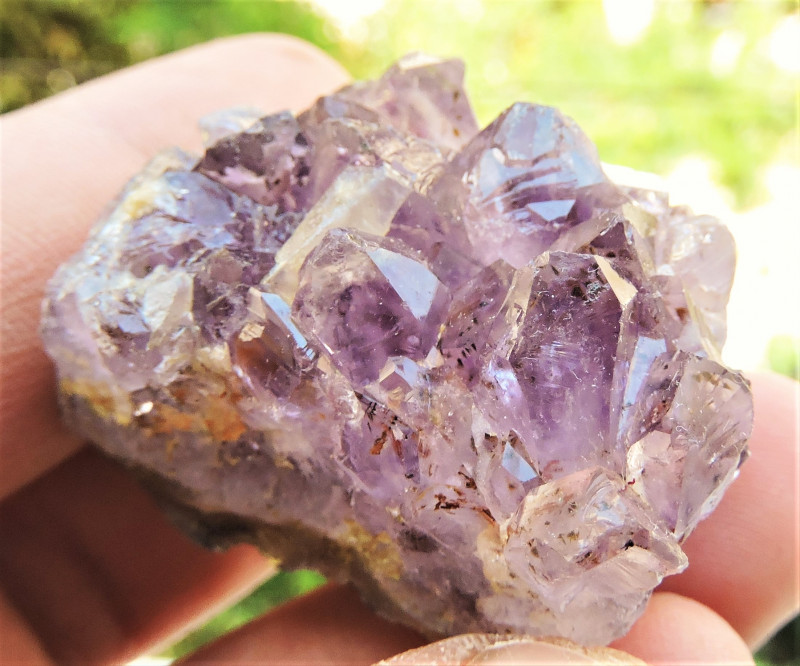
Goethite Gemstone: Properties, Meanings, Value & More
 Goethite is an iron mineral related to hematite that’s often found inside other gemstones. Is goethite rare or common? Goethite is an abundant mineral and the most common iron oxide mineral. It’s also the most common part of iron rust.
Goethite is an iron mineral related to hematite that’s often found inside other gemstones. Is goethite rare or common? Goethite is an abundant mineral and the most common iron oxide mineral. It’s also the most common part of iron rust.
What does goethite look like? The crystals can be brown, yellow, or red, though most colors have a brown undertone if they’re not completely brown. You’ll usually see paler tones in smaller crystals and darker tones in larger crystals.
Want to know more? This guide will fill you in on everything you need to know about goethite gemstones, prices, healing properties, and more!

What Is A Goethite Crystal?
Goethite is a semi-precious gemstone often found grown into other gems, usually as an inclusion. One common example is goethite in amethyst, producing purple crystals with yellow, orange, or brown portions. These amethyst goethite stones may be called cacoxenite amethyst, but the inclusions aren’t cacoxenite (an iron phosphate mineral).
Some alternate names for goethite include:
Götheite / Göthite
Allcharite
Brown Iron Ore / Brauneisenerz (German)
Conchilites
Chileit
Fullonite
Mesabite
Ehrenwerthite
Przibramite
Yanthosiderite
Brown Hematite
Brown Ironstone / Braun-Eisenstein (German)
Despite the last few names listed above, goethite is not the same as ironstone or hematite. That said, many of goethite’s uses are similar to the industrial uses of hematite — namely, being used as sources of iron and ingredients in pigments.
Astrologically, goethite is a lucky zodiac stone for Aries.
On the scientific side, what is the goethite mineral and how do you identify it?
Goethite Specifications & Characteristics
As an iron oxide hydroxide mineral, goethite’s formula is FeO(OH), sometimes written as α-Fe3+O(OH). Manganese is a common impurity, and the iron in goethite is typically ferric iron (Fe3).
Goethite is in the diaspore group of metal oxyhydroxides with orthorhombic crystal systems. Other members include diaspore (of course), groutite, tsumgallite, montroseite, and bracewellite.
Some of the most impressive crystal habits of goethite are iridescent stalactites and black clusters of radiating crystals. Other forms include columnar, bladed, and botryoidal (resembling a grape cluster) crystals.
If you’re wondering about magnetism, goethite is magnetic but only weakly.
How do you identify goethite? The most commonly confused mineral is hematite (Fe2O3). Hematite is usually red while goethite is often brown or yellow. Also, hematite is slightly harder, ranking at 5.5-6.5 on the Mohs mineral hardness scale.
If you have a spectrometer, you can check absorption lines for identification. Real goethite will show absorption at 420, 480, 600, and 920nm. Hematite’s absorption lines are at 520, 650, and 880nm.
Here are the remaining goethite properties:
Mohs hardness: 5-5.5
Color: Yellow, brown, black, orange, reddish-brown, yellowish-brown, brownish-black, silver
Crystal structure: Orthorhombic
Luster: Adamantine, silky, metallic, or dull
Transparency: Opaque to subtranslucent
Refractive index: 2.26 to 2.398
Density: 4.27 - 4.29
Cleavage: Perfect on [010], imperfect on [100]
Fracture: Irregular/uneven or splintery
Streak: Brownish-yellow to yellow
Birefringence: 0.138
Luminescence: None
Pleochroism: Present and strong in red/yellow, red/brownish-yellow, and red/orange-yellow
Dispersion: Fairly strong
Now, is there more than one type of goethite? Yep!

Types of Goethite
There are a few different goethite varieties. Most of them have tricky names, but they’re not complicated to understand.
Ehrenwerthite: Goethite that has partially formed after pyrite, creating a combination of the two
Alumogoethite: Goethite containing aluminum
Sammetblende or Samtblende: Derived from the German term for “velveit,” a goethite variety made up of tiny needle-like crystal spheres or crusts, giving it a fuzzy carpet look with a velvet-like luster
Wood Iron: Goethite with fibrous crystal habit
It’s important to note that “wood iron” is also the name for a fibrous siderite variety.
As you know, you’ll often see goethite inside of other stones like amethyst. Some other gems that contain goethite layers or inclusions include:
In stones like aventurine and sunstone, tiny flakes of goethite (though sometimes hematite or pyrite) are often responsible for the metallic glittering effect called aventurescence.
Now that you know the mineral side, what is the meaning of goethite?

Goethite Meaning & History
The goethite crystal meaning ties to connection with Mother Earth and the celestial realm. The stone is great for grounding yourself as you explore a higher spiritual connection.
It extends its connections to the wearer, keeping you securely in reality as you connect to angels or other ethereal beings to gain a greater perspective on the world.
German mineralogist Johann Georg Lenz discovered and named goethite in 1806 after finding the original samples in Herdorf, Germany. He chose the name to honor another Johann, the renowned German scientist and poet Johann Wolfgang von Goethe.
Goethe was also an author, playwright, politician, and philosopher, on top of serving as Chief Minister of Weimar, Germany. Talk about a jack of all trades!
Goethite’s history extends well beyond 1806, however. Since the Paleolithic era of strictly hunter-gatherer societies (from 2.5 million years ago to 10,000 BC), people have ground goethite to create paint pigment. They still do today!
In the past, goethite was a popular pigment source for brown or yellow ochre pigments. Archeological evidence revealed goethite within cave paintings in the popular Lascaux cave network of France dating back over 16,000 years!
Another notable example ties to a king with a legendary golden touch — King Midas. Well, his dad. The tomb of a man believed to be King Gordias, Midas’s father, contained a burial shroud colored by goethite dye. Though it's understandably changed in color over time, the original color likely resembled gold.
In fact, some historians theorize that the entire myth of the “Midas Touch” came from the habit of him and other royalty at the time to wear gold-colored clothes.
If your life needs a golden touch, you’ll be happy to hear that goethite is a powerful healing crystal! So, what does goethite do spiritually?

Goethite Healing Properties
The color of every gemstone influences its powers as a healing stone. Yellow goethite, like all yellow gemstones, offers greater joy, concentration, and hope. Meanwhile, brown goethite is a chakra stone for the root chakra, joining other brown gems in opening the energy center to bring you grounding and stability.
Next, we’ll look at the physical, emotional, and chakra healing benefits of goethite.
Physical Healing
Crystal healers use goethite to treat problems related to the following:
Ears
Eyes
Digestive system
Throat
Nose
Veins
The crystal is also believed to facilitate a more seamless, speedy recovery after physical trauma or significant wounding.
Emotional Healing
Goethite’s emotional benefits are helpful during many times in life: the start of a new project, a period of grief or loss, and even during a long-term romantic relationship.
This crystal is said to boost creativity and help give you the concentration and confidence to complete any creative endeavor. For those dealing with loss, goethite is a supportive and healing companion. Lastly, if you’re trying to voice your desires or feelings more honestly — whether those feelings are intimacy-based or otherwise.

Pictured above: Amethyst with goethite inclusions
Goethite Gemstone Properties
Experts grade goethite and determine its value by looking at its color, cut, clarity, and treatments.
Color
Besides goethite’s earthy brown, yellow, and reddish hues, it can also show multiple colors! The stone may be color-banded and in some cases, iridescent (especially specimens from Tharsis, Spain).
Iridescence comes from thin layers of turgite (a mixture of hematite and goethite) on the surface that cause thin-film interference. You’ll often see iridescence on stalactic or botryoidal specimens, which are sometimes sold as “rainbow goethite.”
Cut
Goethite alone is almost never faceted, though other stones containing it may be faceted (e.g. goethite in amethyst). Typically, goethite is cut into freeform shapes, cabochons, or tumbled stones. Iridescent or color-banded goethites are commonly seen in cabochon jewelry.
Additionally, raw goethite specimens with interesting features or shapes are often sold uncut as beautiful collector’s pieces.
Clarity
Goethite is almost always opaque or nearly opaque, so inclusions don’t affect its appearance as much as they would in transparent stones. That said, goethite inclusions in other stones are incredibly versatile.
For instance, many types of quartz contain goethite inclusions, but the inclusions can show up differently in each stone. Some may be fans, others dendrites, and still others may resemble organ-pipes.
Treatments
Historically, goethite has been heated to become red, then used for creating red pigments. Heat treatments can also make brown goethite yellow.
Before all the grading happens, how does goethite form?

Goethite Formation & Sources
Goethite can form in a few different ways. The most common process is when iron-rich minerals undergo weathering, oxidizing to change their ferrous (Fe2+) iron to ferric (Fe3+) iron. This oxidation means goethite is often found at Earth’s surface.
Other formation processes for goethite include groundwater precipitation or the hydrothermal process (element-rich water settling into crevices and precipitating). Another fascinating but less common formation process is biological, where certain bacteria excrete the mineral. Nature is wild, right?
Back to the oxidation formation, sometimes the initial mineral doesn’t entirely become goethite. In these cases, we have pseudomorphs or combinations of goethite and other minerals. Some common examples are goethite pseudomorphs after pyrite, marcasite, or siderite.
You can find goethite in many areas, though soils are the most common. Other environments include bogs, swamps, cave floors, creek beds, and the bottom of lakes.
Geographically, where is goethite found?
Mining Locations
Goethite has been found all over the world. Nigeria is a particularly significant source of gem-quality goethite, while Cuba, England, and the USA are important deposits in general.
Other important goethite sources are:
Australia
Canada
Czechia
France
Germany
USA (Alabama, Colorado, Georgia, Minnesota, Missouri, Tennessee, Virginia)
Though not as abundant, another notable occurrence of goethite is on Mars. Yep, the planet Mars! Not only does this make goethite a space gemstone, it’s also helped scientists learn more about if there was once water on Mars.

Goethite Price & Value
Most goethite currently available is rough. Cut stones are usually goethite in other gems, with most being amethyst containing goethite.
Faceted amethyst with goethite gems range from around $4-$20 per carat at wholesale. In cabochon form, these gems fetch about $25 to $75 each.
Rough goethite specimens vary in price based on their features, size, and rarity. For instance, iridescent goethite specimens are the priciest, ranging from roughly $40 to $350 each.
Raw amethyst in goethite is significantly more affordable at around $10 each. Other forms of raw goethite go for $10 to $35 at wholesale prices.
Goethite Care and Maintenance
Lastly, we’ll discuss proper gemstone care for goethite. This mineral has relatively good hardness, but its perfect cleavage means a hard blow from the right angle can leave the stone shattered. For that reason, we recommend goethite jewelry with protective settings.
It’s important to keep goethite away from harsh chemicals or acids — that especially goes for hydrochloric acid, which will cause goethite to dissolve.
To clean goethite safely, use a soft toothbrush dipped in a mixture of warm water and mild soap. You may not even need the soap, so you can also try to clean it first with just water and the toothbrush to see if it does the trick.
Keep goethite away from other gemstones in a cool, dry place.

Go Go Go with Goethite Gems!
Whether we’re talking about its ties to a legendary king, its presence in cave paintings, or simply its naturally beautiful forms, goethite is a gem worth knowing about. If you’re looking for some motivation, focus, and creativity to keep you going, goethite may just be the perfect stone for you!
Search the Gemstone Encyclopedia
Related Auctions
Related Articles
Originally the Birthstones or gemstones were associated with a zodiac sign or the month of a individuals birth. Find out what your stone is and view the stones we have for sale
8th Feb 2021
There are dozens of quartz and chalcedony gems with various colors and patterns. Learn all about quartz properties and every type of quartz, from amethyst and agate to plasma and phantom quartz!
15th Oct 2020
Hackmanite is a pink to violet sodalite gem known for its unique color-change and luminescence. Learn why hackmanite is special, from its rare qualities to the types of hackmanite jewelry available.
28th Mar 2018
Latest Articles
Friedelite is an uncommon pink, red, or brown manganese silicate mineral best known from New Jersey and South Africa. Learn the prices, properties, uses, and history of friedelite gemstones.
23rd Dec 2024
Shortite is a rare mineral and rarer gemstone, usually found as colorless or yellow wedge-shaped crystals. Learn the value, history, and properties of shortite in this guide!
9th Dec 2024
Senarmontite is an uncommon antimony mineral mostly used industrially but occasionally collected as rare gems or pearly crystals. Find out all of the traits, uses, prices, and history of senarmontite.
27th Nov 2024
Article Categories
How To's is where you will find helpful articles from gem Rock Auctions on how to cut gemstones, select gemstones and buy gemstones.
9 Articles




